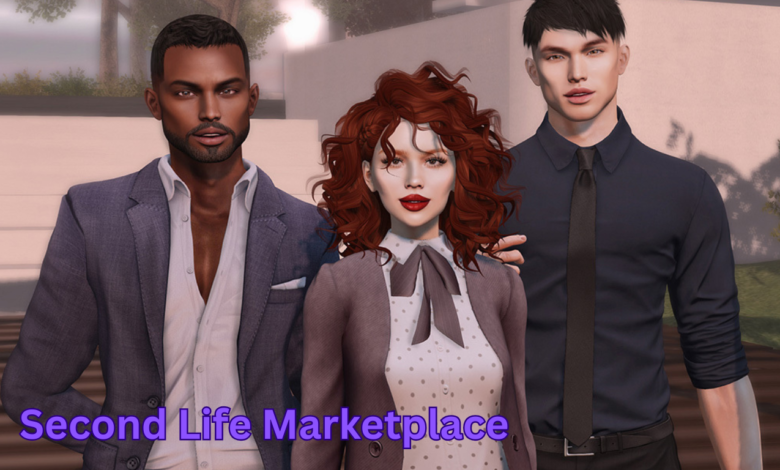Second Life Marketplace A Complete Guide to Virtual Shopping and Digital Creativity

The Second Life Marketplace is one of the most fascinating virtual economies in the world. It is the official online shopping platform for Second Life, the immersive 3D virtual world created by Linden Lab. Unlike typical online stores, this marketplace caters to avatars—digital representations of users—who engage in buying and selling virtual goods, services, and experiences.
For millions of users, Second Life is more than just a game. It’s a virtual society where you can create, explore, socialize, and earn money through creativity. The marketplace acts as the central hub for this economy, enabling users to purchase clothing, accessories, houses, land tools, animations, and even entire businesses.
In this article, we’ll explore the history, features, benefits, and opportunities within the Second Life Marketplace. We’ll also discuss how to get started as both a buyer and seller, strategies for success, and the role this digital economy plays in shaping the future of virtual worlds.
What is Second Life
Before diving deeper into the Second Life Marketplace itself, it’s important to understand Second Life. Launched in 2003 by Linden Lab, Second Life was one of the first virtual platforms to combine social networking, creativity, and commerce. Unlike traditional video games, it doesn’t have set goals or missions. Instead, it’s a sandbox environment where users (often called “residents”) create their own experiences.
The platform became famous for its:
- User-generated content.
- Avatar customization.
- Real estate trade.
- A fully functioning virtual economy tied to real-world money.
Second Life uses its own virtual currency called the Linden Dollar (L$), which can be exchanged for real-world money through the official exchange system. This integration makes the Second Life Marketplace not just a virtual store but a gateway to genuine income opportunities.
The Evolution of the Second Life Marketplace
When Second Life first launched, all transactions happened in-world, meaning residents had to visit virtual shops and stores to buy items. As the platform grew, Linden Lab recognized the need for a centralized online marketplace.
- 2005–2008: Residents primarily relied on in-world shops. This gave the platform a unique charm but also made shopping time-consuming.
- 2009: Linden Lab introduced “Xstreet SL,” an early version of the marketplace.
- 2010: Xstreet SL was rebranded as the Second Life Marketplace, becoming the primary hub for online purchases.
- Present Day: The marketplace features millions of items and continues to expand, providing both convenience and exposure for sellers.
This evolution reflects how digital commerce adapts to user needs—providing accessibility while still supporting in-world shopping experiences.
How Does the Second Life Marketplace Work?
The Second Life Marketplace operates similarly to popular e-commerce platforms like Amazon or Etsy, but with a digital twist.
For Buyers
- Browsing Products – Shoppers can browse categories such as clothing, avatars, animations, buildings, furniture, and scripted objects.
- Purchasing Items – Items are bought using Linden Dollars (L$). Once purchased, they are delivered to the buyer’s inventory in-world.
- Customization – Many products come with customization options, allowing buyers to tweak colors, textures, or shapes.
- Delivery System – After purchase, items are automatically transferred to the buyer’s avatar inventory.
For Sellers
- Setting Up a Store – Users can create a merchant account, upload products, set descriptions, and price them in L$.
- Commissions and Fees – Linden Lab charges a small commission on each sale.
- Marketing – Sellers can boost visibility through featured listings and smart descriptions.
- Earning Real Money – Linden Dollars earned can be exchanged for USD or other currencies.
Why the Second Life Marketplace Matters
The Second Life Marketplace is more than a shopping tool; it represents a digital economy that mirrors real-world commerce.
1. Accessibility
Users don’t need to spend hours wandering through in-world stores. Instead, they can browse thousands of listings, filter by price or category, and complete purchases instantly.
2. Economic Opportunities
Talented creators can build real businesses by selling clothing, architecture, scripts, or animations. Many residents earn full-time incomes through the marketplace.
3. Community Growth
The marketplace brings residents together by enabling collaboration. For example, a 3D modeler might work with a texture artist to create high-quality products.
4. Virtual Innovation
The marketplace encourages innovation by giving creators an outlet for their ideas. From futuristic vehicles to realistic fashion, the possibilities are endless.
Categories of Products in the Second Life Marketplace
The marketplace features an incredible range of products, catering to every possible aspect of virtual living.
1. Avatars and Skins
Avatars define how you look in Second Life. The marketplace offers humanoid, animal, robotic, and fantasy avatars. Custom skins enhance realism or creativity.
2. Clothing and Accessories
Virtual fashion is a booming industry. Residents can purchase dresses, suits, shoes, jewelry, and even makeup. Fashion shows are common, highlighting the importance of digital style.
3. Buildings and Real Estate
Entire homes, skyscrapers, castles, and nightclubs can be bought. Some come as pre-made builds, while others are modular for customization.
4. Animations and Gestures
From dance moves to handshakes, animations allow avatars to interact naturally. These small touches enhance social experiences.
5. Vehicles and Gadgets
Cars, planes, spaceships, and futuristic gadgets are popular among explorers. Many are scripted to function like real vehicles.
6. Scripts and Tools
Programmers sell scripts that power interactive objects, games, and businesses.
7. Furniture and Decor
From couches to lighting systems, furniture helps personalize homes and public spaces.
How to Start Buying on the Second Life Marketplace
If you’re new, here’s a step-by-step guide:
- Create a Second Life Account – Sign up at the official website and download the viewer.
- Log in and Customize Your Avatar – Basic customization is free, but premium items come from the marketplace.
- Add Linden Dollars to Your Account – Use real-world money to buy L$, which you’ll need for purchases.
- Browse and Shop – Explore the marketplace, read product descriptions, and check seller ratings.
- Purchase and Receive Items – Items appear in your inventory under the “Received Items” folder.
How to Become a Seller on the Second Life Marketplace
Selling on the Second Life Marketplace is a rewarding opportunity.
- Create a Merchant Account – Upgrade your Second Life account to a merchant profile.
- Prepare Your Products – Ensure your items are original, functional, and ready for upload.
- Upload and List – Add descriptions, keywords, and attractive images.
- Set Prices in L$ – Decide whether to target budget shoppers or premium buyers.
- Manage Your Store – Keep track of sales, update products, and respond to customer queries.
- Cash Out – Convert your Linden Dollars into real money using the Linden Lab exchange.
Tips for Success on the Second Life Marketplace
For Buyers
- Always read reviews and seller ratings.
- Watch for free demos before buying premium products.
- Use filters to narrow down search results.
For Sellers
- Write detailed product descriptions with keywords.
- Use high-quality images to showcase products.
- Offer customer support for better ratings.
- Update listings regularly to stay relevant.
Economic Impact of the Second Life Marketplace
The marketplace isn’t just about fun—it has a real-world economic footprint.
- Linden Lab reported that creators collectively earn millions of dollars annually.
- Small businesses thrive, from solo designers to larger studios.
- The platform proves that virtual economies can be sustainable and impactful.
The Future of the Second Life Marketplace
As technology evolves, so will Second Life. With the rise of VR and AI, the marketplace is expected to integrate:
- Virtual Reality Shopping – A more immersive browsing experience.
- AI-Powered Recommendations – Personalized shopping for each user.
- Blockchain Integration – Potential for more secure transactions.
- Cross-Platform Expansion – Extending beyond Second Life into other metaverse platforms.
FAQs About the Second Life Marketplace
1. What is the Second Life Marketplace?
It is the official online shopping hub for Second Life, where residents can buy and sell virtual goods using Linden Dollars.
2. How do I buy items from the marketplace?
Log in with your Second Life account, purchase using L$, and items will be delivered directly to your in-world inventory.
3. Can I make real money selling items?
Yes. Earnings in Linden Dollars can be exchanged for real-world currencies through Linden Lab’s exchange system.
4. Do I need to own land in Second Life to sell items?
No. You can sell items directly on the marketplace without owning virtual land.
5. Is it safe to buy items from the Second Life Marketplace?
Yes, but always check seller ratings and reviews to avoid low-quality or fraudulent items.
Conclusion
The Second Life Marketplace is a unique blend of e-commerce, creativity, and virtual living. It provides an accessible platform for buyers to enhance their experiences and for sellers to turn imagination into income. Whether you’re a casual user looking for new clothes for your avatar or an ambitious creator aiming to build a virtual business, the marketplace offers endless possibilities.
In many ways, it’s a preview of the future digital economy—a world where creativity, commerce, and community intersect. As technology continues to advance, the Second Life Marketplace will remain a cornerstone of virtual innovation and human imagination.



